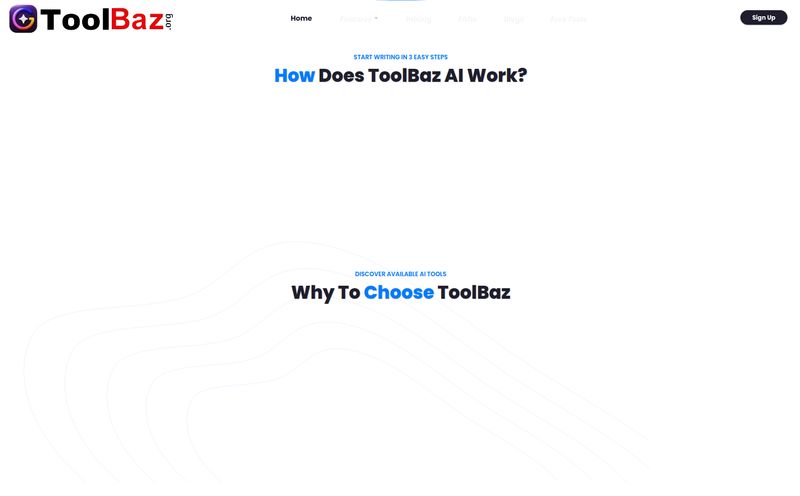If you've ever tried to set up Stable Diffusion on your own computer, you know the pain. You follow a 45-minute YouTube tutorial, your command prompt starts screaming at you about Python dependencies, and you suddenly feel like you need a computer science degree just to make a picture of an astronaut riding a unicorn. My first attempt took an entire Saturday. An entire. Saturday. And the end result was... well, let's just say my GPU sounded like a jet engine trying to render a potato.
It's the biggest barrier to entry for one of the most powerful creative AI tools out there. We just want to make cool stuff, not become part-time IT support for our own machine. This is where managed solutions come in, promising to handle all the technical nonsense so you can just... create. I’ve seen a few pop up, but one called Stadio recently caught my eye. It claims to offer the full, unadulterated Automatic1111 experience, but without any of the setup. So, does it live up to the hype? I had to find out.
What Exactly is Stadio? And Why Should You Care?
Think of Stadio like this: it's a fully-equipped, professional-grade creative studio that you can rent by the hour, and it exists entirely in the cloud. You don't have to buy the expensive cameras, soundproof the walls, or wire the lighting yourself. You just walk in, and everything is there, ready for you to work your magic.
In technical terms, Stadio provides a managed instance of the Automatic1111 Stable Diffusion Web UI. For those in the know, Automatic1111 (or A1111) is the gold standard. It's the most powerful, flexible, and widely used interface for Stable Diffusion, giving you granular control over every aspect of your image generation. Stadio basically hosts this powerful tool on their own super-fast servers, so you can access it from any web browser on any computer, no matter how wimpy it is. You're using their powerful GPUs, not your own.
This is a big deal for anyone who has been put off by the technical hurdles or the steep hardware costs associated with high-end AI art generation.

Visit Stadio
The Features That Actually Matter
Okay, so it's A1111 in the cloud. Cool. But lots of platforms are trying that. Where Stadio seems to want to make its mark is in the details and the quality-of-life improvements. After playing around with it, a few things really stood out.
The Endless Model Library (Well, Almost)
Anyone who uses Stable Diffusion develops a bit of a... problem. We become model hoarders. We spend hours on sites like Civitai, downloading dozens of specialized models—one for photorealism, one for anime, one for that cool paper-cut style. Stadio comes pre-loaded with over 3,000 models. Three. Thousand. That's just nuts. The time saved from not having to hunt down, download, and upload every single model is immense.
And for the control freaks among us (guilty!), they still let you upload your own custom models, LoRAs, and Textual Inversions. So you get the best of both worlds: a massive pre-vetted library and the freedom to bring your own secret sauce to the party.
Full Automatic1111 Power with Extensions
This isn't some watered-down, “easy mode” version of Stable Diffusion. Stadio gives you access to the all-important extensions that turn A1111 from a cool toy into a professional tool. I'm talking about things like:
- ControlNet: The absolute game-changer for getting the exact pose or composition you want.
- Deforum: For creating those trippy, morphing AI animations that are all over social media.
- Pixelization extensions and more: Basically, if there's a popular A1111 extension, you can likely use it.
This proves they understand their audience. They know that serious users need more than just a text prompt box; they need a full suite of controls.
Blazing Fast GPUs (No More Toaster Ovens)
Let's be honest, waiting 5 minutes for a batch of four images to generate on a local RTX 3060 kills the creative flow. You have an idea, you type it out, and then... you wait. By the time the image is done, your creative spark has fizzled. Using Stadio, generations were fast. Really fast. That speed allows for rapid iteration. You can try an idea, tweak it, try again, and again, all in the time it would take to generate a single image on a mid-range gaming PC. It feels less like a chore and more like a conversation with the AI.
The Good, The Bad, and The GPU-Powered
No tool is perfect, right? Stadio is incredibly compelling, but it's not without its trade-offs. The biggest advantage, without a doubt, is the sheer convenience. The promise of zero setup is delivered. You log in and you're ready to go. For artists, marketers, or small agencies where time is money, this is a killer feature. The huge library of models and the raw power of the underlying hardware mean you can produce better work, faster.
However, there are a couple of things to keep in mind. The first is the one that's on everyone's mind: pricing. The website doesn't list a clear pricing table, instead opting for a "Contact us" form. This usually hints that it's geared more towards teams, businesses, or serious users rather than casual hobbyists, and pricing might be based on usage or custom plans. This could be a hurdle for some folks. The second consideration is the nature of any cloud service—you're reliant on their infrastructure. If Stadio has downtime, your workflow is on pause. It's the classic trade-off between the absolute control of a local install and the convenience of a managed service. For my money, the convenience usually wins.
So Who Is Stadio Really For?
I see a few groups of people who would get a massive benefit from a platform like this.
First, the frustrated creative. This is the digital artist, the illustrator, the designer who sees the potential of AI but gets stonewalled by the technical side. Stadio removes that wall completely.
Second, small agencies and marketing teams. Need to create a specific image for a campaign with a consistent character or style? Upload your custom LoRA, fire up ControlNet, and generate dozens of options in minutes, not hours. It’s a force multiplier.
Finally, the curious developer or power user who wants to push the limits of extensions like Deforum but doesn't want to invest thousands in a new GPU rig just for experimenting. This gives them a powerful playground without the comittment.
Who isn't it for? Probably the hardcore tinkerer who genuinely enjoys the process of managing their own local setup and has already invested in the hardware. But for everyone else? It's mighty tempting.
Your Stadio Questions, Answered
Frequently Asked Questions
How much does Stadio cost?
Pricing information isn't public on their site. You'll need to use their contact form to get details. This often means they offer tailored plans for different levels of usage, from individuals to larger teams.
Can I use my own models and LoRAs?
Absolutely. This is one of its strongest features. You can upload your own custom models, LoRAs, and other files to create images in your unique style.
Is this just a simplified version of Stable Diffusion?
Not at all. It's the full-featured Automatic1111 Web UI, which is considered the most powerful and comprehensive interface. You get all the advanced settings and extension support you'd expect from a local installation.
Do I need a powerful computer to use Stadio?
Nope! That's the beauty of it. Since everything runs on their powerful cloud servers, you can use Stadio from virtually any computer with a modern web browser. Your machine just needs to be able to browse the internet.
What is Automatic1111, anyway?
It’s the de facto open-source user interface for running Stable Diffusion. It's beloved by the community for its vast array of features, sliders, and options that give you fine-grained control over the AI image generation process.
Is Stadio better than a tool like Midjourney?
It's not better or worse, just different. Midjourney is known for its beautiful, artistic results from very simple prompts, but it offers less control. Stadio gives you the raw power and pinpoint control of Stable Diffusion, which is better for projects that require specific compositions, poses, or styles.
The Final Verdict: Is Stadio Worth It?
Look, the AI creative space is moving at a breakneck pace. Tools that were revolutionary six months ago are now standard, and the biggest thing holding people back is often access and ease of use. Stadio directly attacks that problem.
It takes the most powerful, and admittedly intimidating, Stable Diffusion interface and makes it as easy to access as a Google Doc. It's not just about avoiding a setup headache; it's about reclaiming your time and mental energy to focus on what actually matters: being creative.
While the pricing model remains a bit of a mystery, for any serious creator or business, the value proposition is clear. The time saved, the access to cutting-edge hardware, and the sheer creative potential it puts at your fingertips is hard to ignore. For me, it represents a huge step in making truly powerful AI tools accessible to everyone, not just the tech-savvy. And that's something I can definitely get behind.
Reference and Sources
Stadio Official Website: For direct information and contact, visit stadio.dev
AUTOMATIC1111 GitHub Repository: To learn more about the underlying web UI, check out the official project page.
Civitai: A popular community for discovering and sharing Stable Diffusion models, which can be found at civitai.com.



